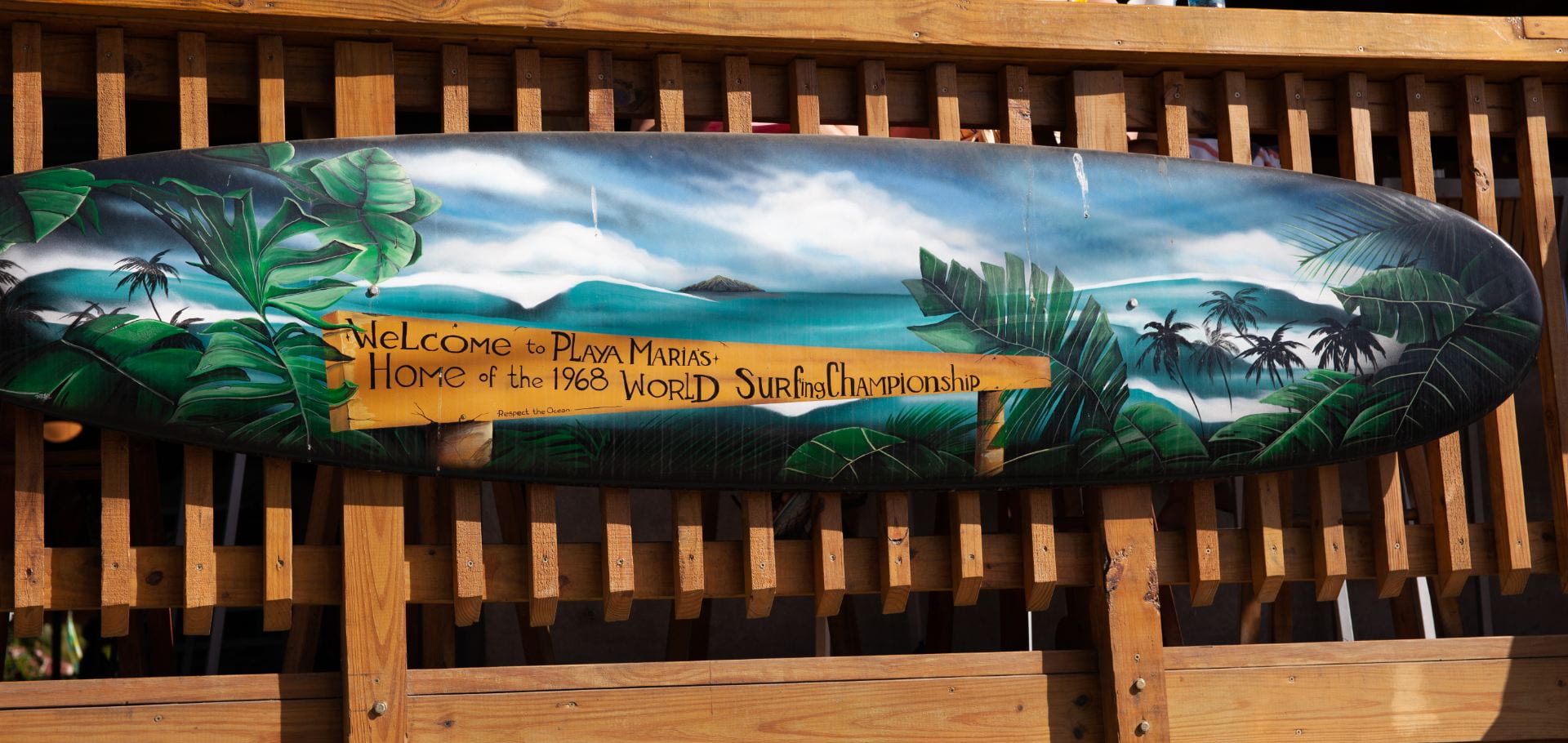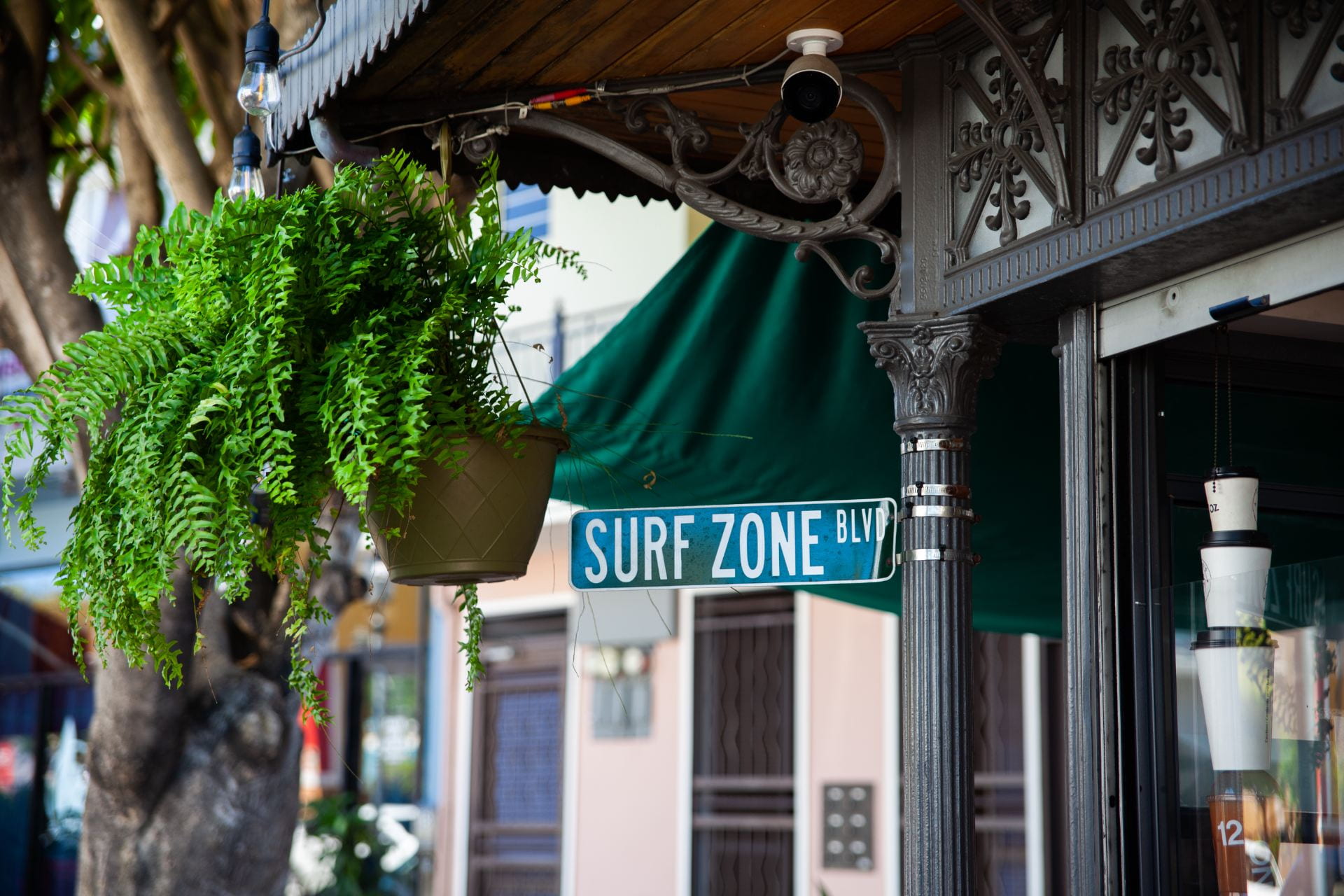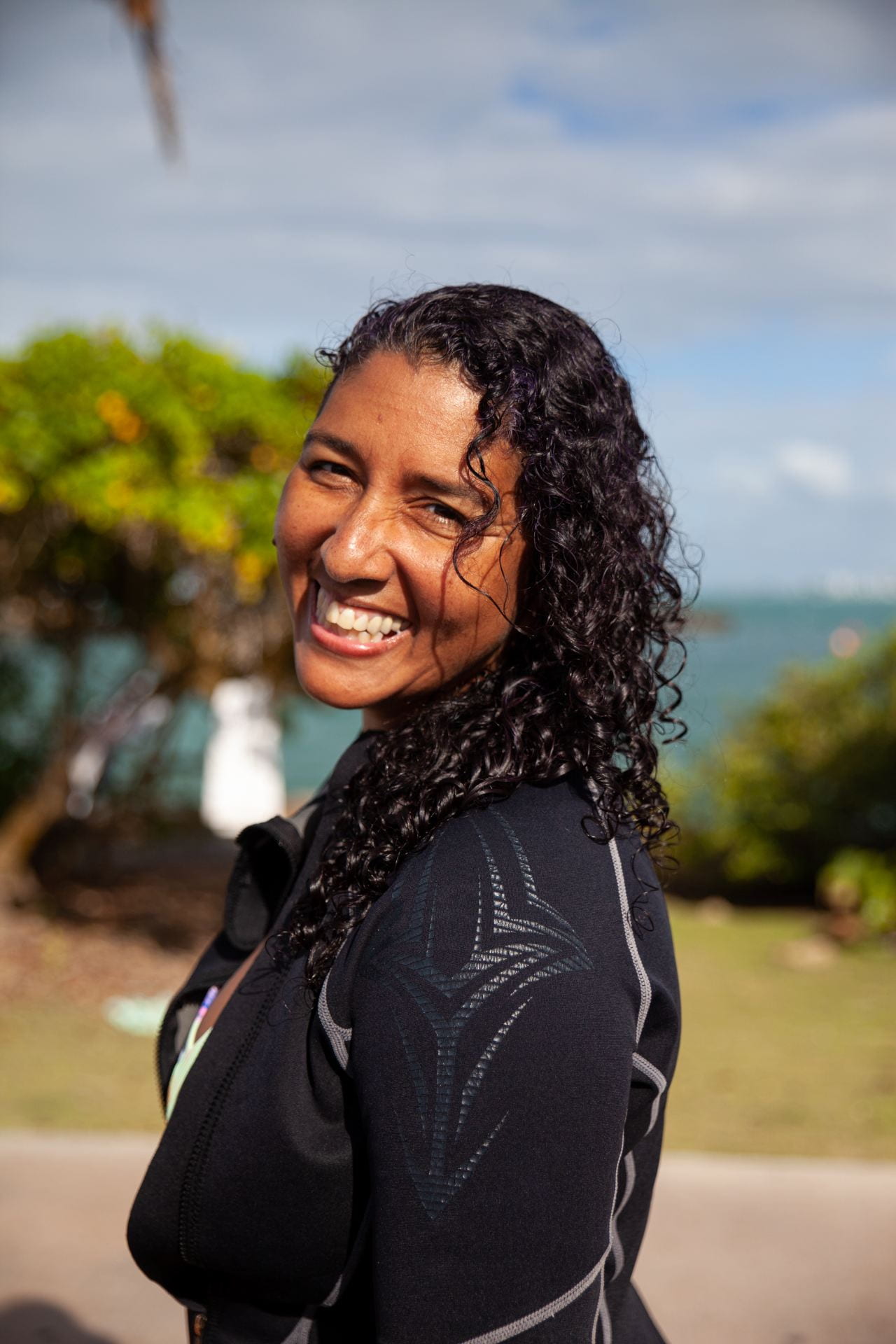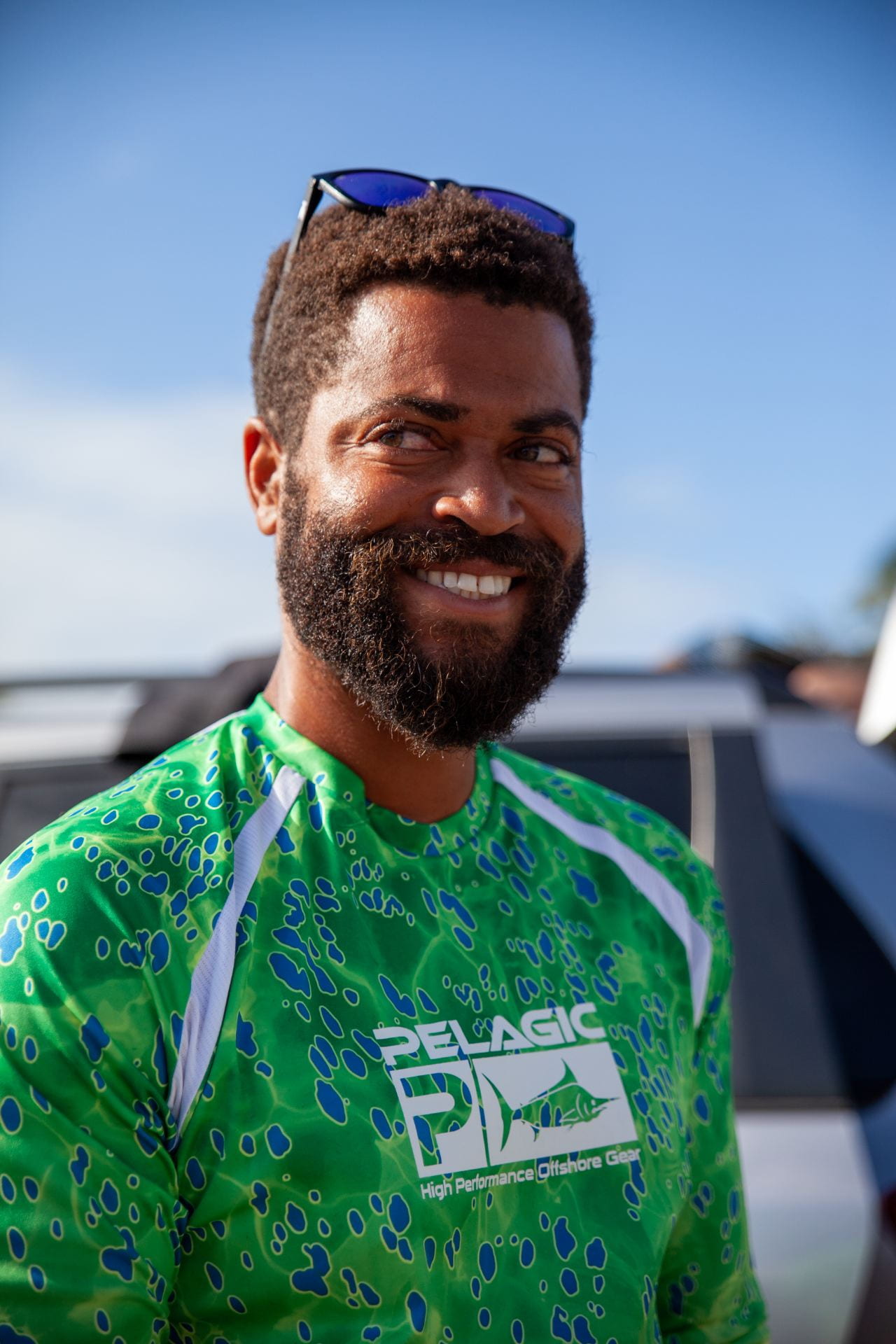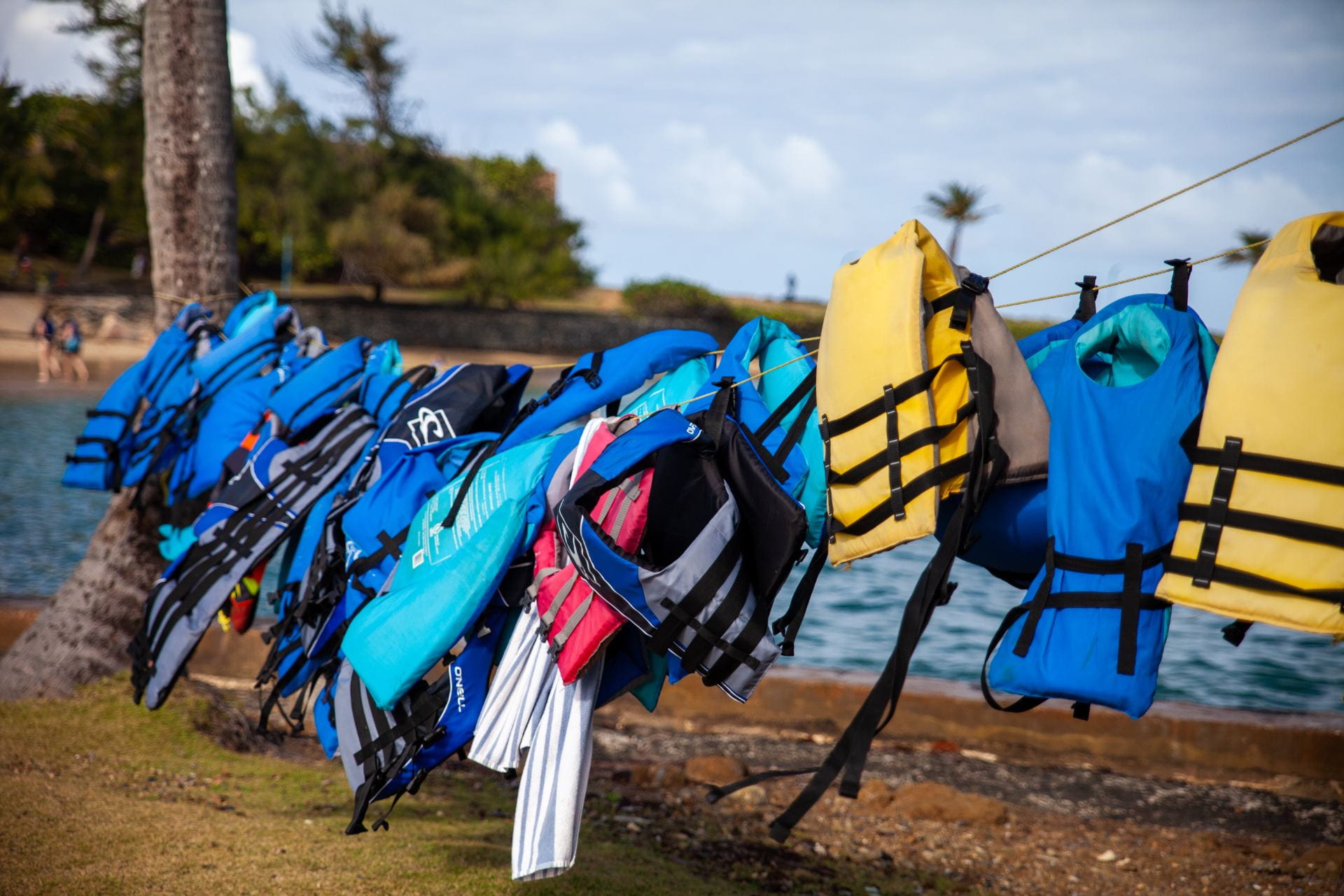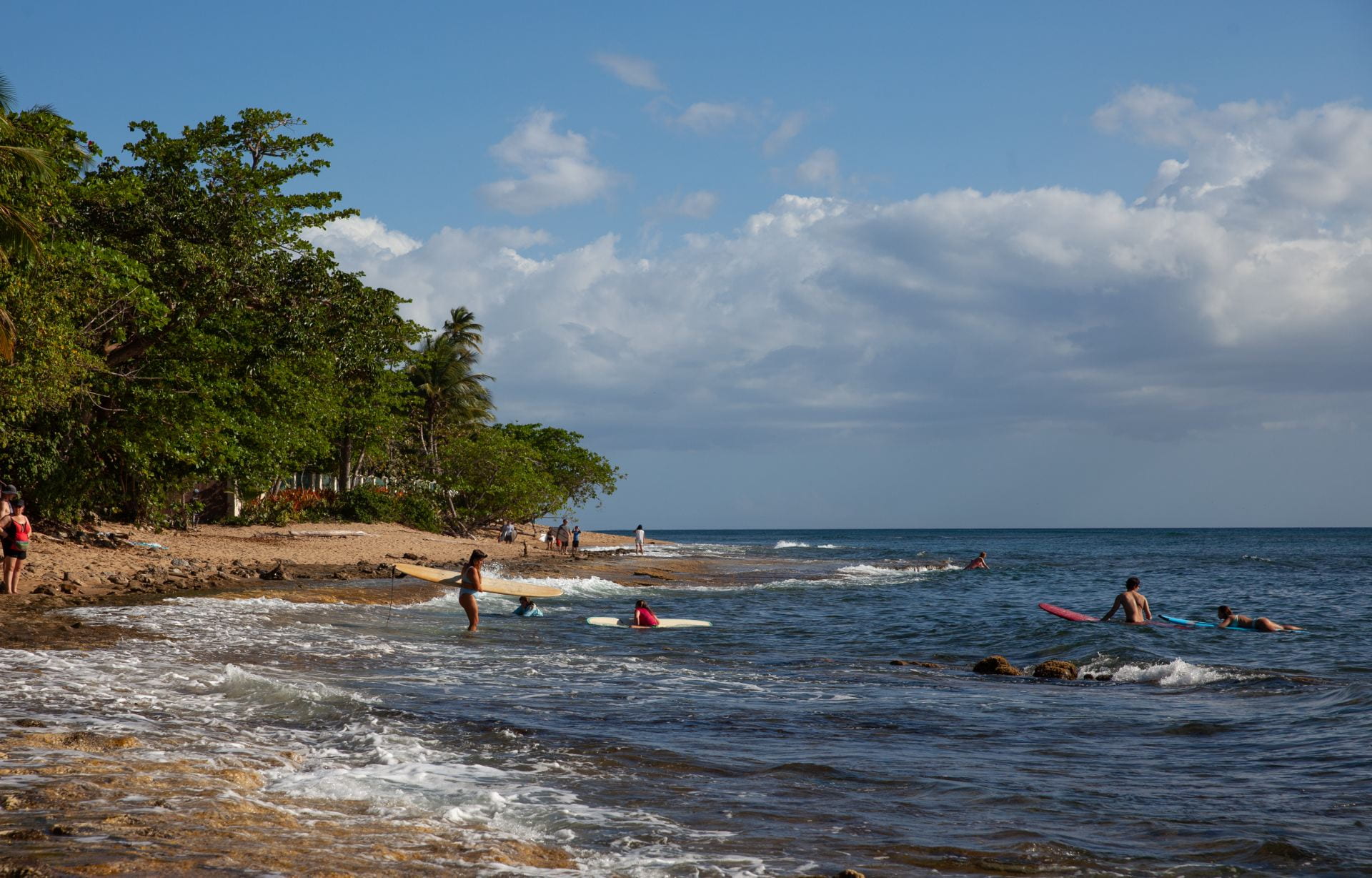
Photo by Elisabeth Hadjis | Surfers paddle into the waves at Maria’s Beach on a Monday evening.
By Elisabeth Hadjis
RINCÓN, Puerto Rico – Draped in the golden glow of the 5 o’clock sun, 18-year-old Summer Richley crouches down in the sand at Maria’s Beach, her hands moving in focused circular motions as she applies wax to her lemon-yellow surfboard.
Like dozens here on this Monday in early March, Richley is preparing for an evening ride among the waves in the Tres Palmas Marine Reserve — a square of protected ocean spanning 204 acres, located off the coast of Puerto Rico’s westernmost town, Rincón. This is one of the world’s best surf spots, dubbed “The Hawaii of the Caribbean” for its reef break-style waves similar to those found on Oahu’s North Shore. Since hosting the World Surfing Championship in 1968, the area has been a magnet for those hoping to get a piece of towering turquoise blue swells and a long surf season that lasts almost year-round.
Photos by Elisabeth Hadjis (in order) | At Calypso — a beach bar at Maria’s Beach, Rincón — a painted surfboard commemorates the World Surfing Championship, hosted here in 1968. This event introduced the world to the region’s waves and solidified Rincón’s reputation as a surf community, A decorative street sign pointing to “Surf Blvd.” hangs outside of Friends Café in Rincón.
Unique and unusual for this part of the world, the surf culture is what brings thousands of tourists to the region every year, and Richley is one of them. Raised by surfer parents in Huntington Beach, California, Richley and her family would visit Rincón every year to stay with her uncle, a 25-year resident of the town and surfer known by the community as Scotty G. He’s since passed away, and now, Richley’s back on the island to take advantage of this special surf spot in his honor.
“It’s so magic here,” Richley says as she carries her board into the sea. Offshore, fellow surfers paddle out, some floating like buoys in the distance, patiently waiting for the perfect wave. “The landscape, the water, the green, and the features in the water that you can see, like fish swimming under you and turtles…it’s so beautiful.”
Scientists and conservationists, though, will say that the real magic in this place lies below the water’s surface, in Tres Palmas’ rich marine ecosystem. Beneath the waves, a colorful, biodiverse reef built on two Caribbean coral species, elkhorn and staghorn, plays an essential role in Puerto Rico’s ocean tourism and recreation industry. In addition to offering a safe habitat for marine life like reef fish and turtles — a major draw for snorkeling enthusiasts and scuba divers — the Tres Palmas reef is a barrier for the shoreline, protecting the coast from strong water and breaking swells as they move inland. The result? Crisp, curly waves and world-class surf.
A healthy reef, resilient against the force of the ocean, makes this possible. Luckily, experts say Tres Palmas happens to be one of the healthiest reefs in the Caribbean.

Photo by Elisabeth Hadjis | A piece of dead coral rests on a bench at Rincón’s Lala Beach. Healthy corals are typically colourful and vibrant, fuelled by algae that live in their tissue and serve as the animal’s primary food source. Stressed, ill or dying corals will expel these algae from their bodies, leaving them to turn white in an event called coral bleaching.
René Esteves Amador is the marine extension director for Sea Grant — a coastal resilience initiative funded by the National Oceanic and Atmospheric Administration, or NOAA. A marine biologist and coral specialist by trade, Esteves works in collaboration with the University of Puerto Rico in Mayaguëz to support restoration efforts on the island’s western waters. He says when it comes to resilience and health, shallow reefs like the ones in this part of the Caribbean typically don’t fare as well as Tres Palmas.
“They’re more susceptible to storm events, they’re more susceptible to land-based sources of pollution, and they’re more susceptible to recreational damage,” said Esteves. “But Tres Palmas is a standout, and from my opinion, that’s related to the high energy environment.”
Esteves is referring to the intense wave energy that moves through the Tres Palmas Marine Reserve and the surrounding region. Here the “residence time” of the water is low, meaning it moves through the area frequently rather than staying stagnant. That, paired with powerful northern swells, especially in the wintertime, have forced the coral to grow thicker and lower to the ground — evolutionary traits that keep it from breaking apart in rough waters.
“In the reef itself — the morphology of the elkhorn — you can see that,” he said. “It’s a result of that high energy environment. It’s not typical elkhorn morphology.”
Tres Palmas’ natural resilience aside, Esteves warns that the reef isn’t bulletproof. Since regular monitoring of the coral reefs first took hold in the 1970s, scientists have observed mass mortality events in half of the Caribbean’s coral reef cover, specifically among the acroporids, or the family of corals that Tres Palmas’ elkhorns belong to.
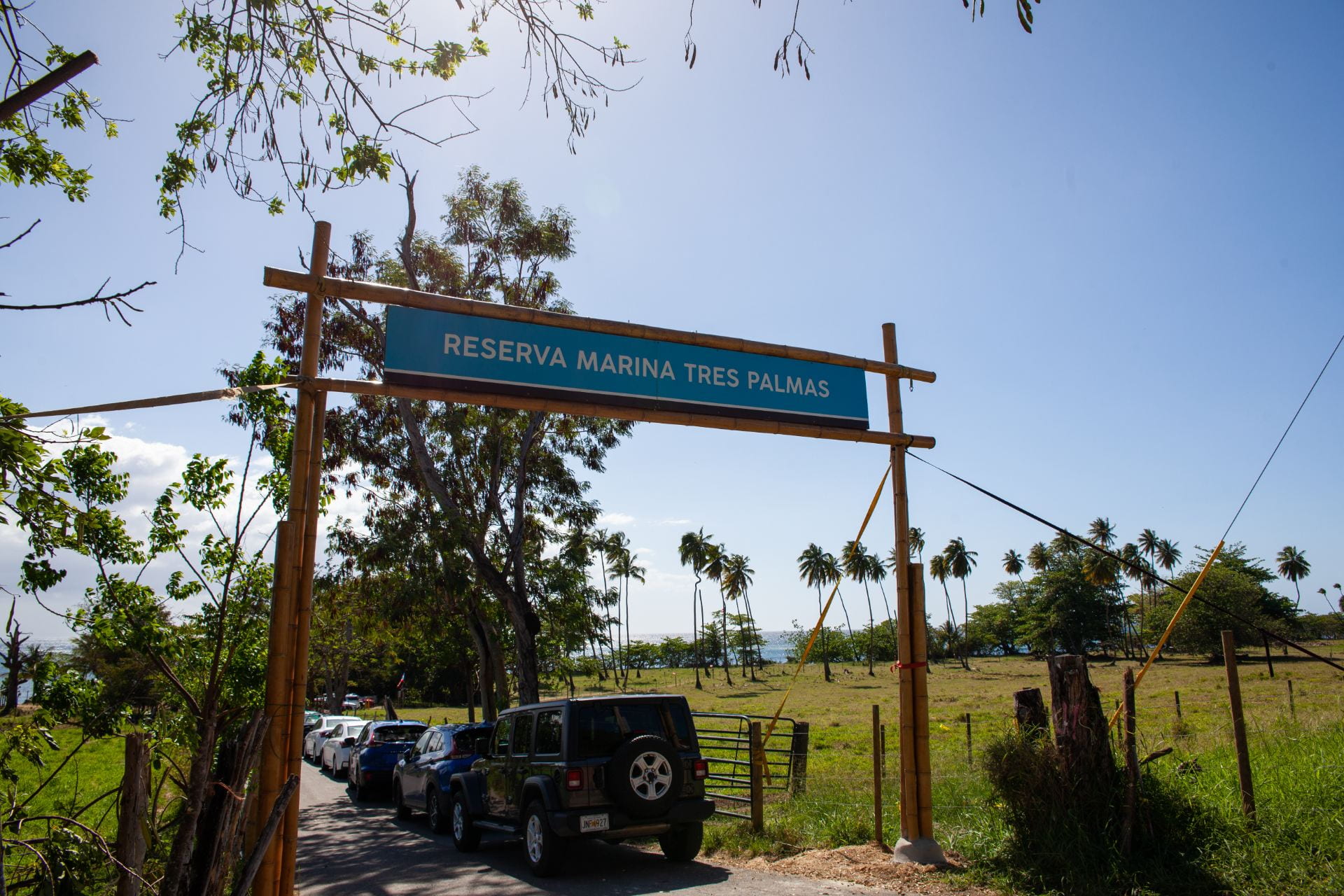
Photo by Elisabeth Hadjis | A banner marks the entrance to Maria’s Beach, one of the access points to the Tres Palmas Marine Reserve, built in March to celebrate the 18th anniversary of the reserve.
The reason for this is partially natural; throughout the 1980s, the region’s elkhorn corals took a hit when an illness called white band disease wiped out 80% of the population. Today, the concern is mostly anthropogenic, with water pollution, ocean warming and acidification posing a serious threat to the survival of the reefs.
Over the past 18 years, protecting Tres Palmas’ coral ecosystem has become a priority for the people of Rincón.
Steve Tamar is one among them. He works as the lab director for the Surfrider Foundation, a network that brings together ocean lovers across the United States in the name of marine conservation. At Surfrider’s Puerto Rico chapter, Tamar runs a water quality testing and management program called the Blue Water Taskforce. Since moving to Rincón 40 years ago, he has seen how the community has rallied together to protect the reef.
“The corals get sick and die or are not reproducing, which cuts down the quality of the wave for surf,” he says, referring to increased water pollution off Rincón’s coast, which he believes is caused by inadequate sewage infrastructure. “But everybody’s stepping up to protect that area. Environmental activism is top on the list for this town.”
This commitment to conservation in Rincón is the very reason why Tres Palmas Marine Reserve exists today. Signed into law by Gov. Sila María Calderón Serra in March 2004, the designation of Tres Palmas as a marine protected area, or MPA — an internationally recognized title that protects the area from overuse and qualifies it as a research and conservation zone — was made possible by a community-driven campaign, with Surfrider Rincón taking the lead.
“The surfing community spearheaded the growth of coral culture [in Rincón],” Tamer says. “Before that, there was a disrespect for the beach here.”
Today, all across town, green posters that read “Salva Tres Palmas” – save Tres Palmas – hang in every surf shop, café and business, a sign of support for local activists fighting against increased development in the area.
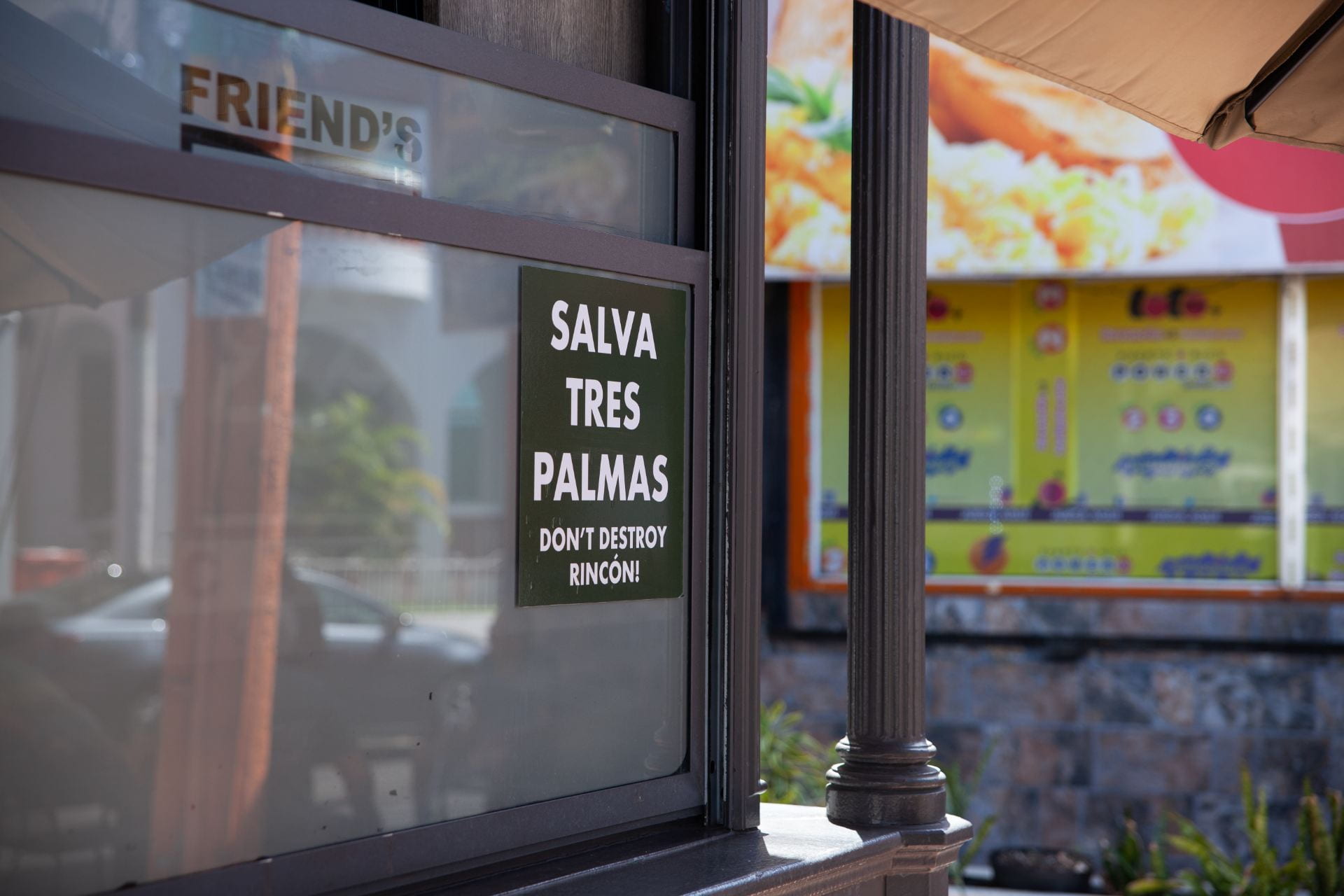
Photo by Elisabeth Hadjis | A sign with the phrase “Salva Tres Palmas” – Save Tres Palmas – is displayed on the window of Friends Café, a coffee shop in Rincón, Puerto Rico’s downtown area. Posters like these are everywhere in Rincón, showing solidarity for those fighting to keep the Tres Palmas Marine Reserve and surrounding ecosystems safe from increasing development in the area.
“The potential for the reef to remain healthy is to increase because of all this effort being put into it,” Esteves said. “It’s that sense of ownership from the community that directly interacts with the ecosystems – that’s key. If that does not exist, then there’s little hope, period.”
A connection to the ocean runs deep in Rincón, but it’s not exclusive to this part of the island. Throughout Puerto Rico’s over 270 miles of coastline, and especially on its eastern side, there are coral reefs too. Once as healthy and biodiverse as their counterparts in the west, the offshore reefs stretching from San Juan to Fajardo and the island of Culebra have lost much of their living coral cover in the past 30 years, mainly because of increased development in Puerto Rico’s more densely populated tourist areas. This is on top of stony coral tissue loss disease — an coral-killing illness that has been spreading to reefs across the Caribbean since 2014.
The loss of an entire reef is hard to picture for most. But for those in the ecotourism industry, swimming among dead reefs is a daily reality.
Balneário del Escambrón, located halfway between the neighborhoods of Condado and Old San Juan, is a go-to beach for both locals and tourists in the capital city region. With surfable waves on one side and a calm, reef-enclosed bay on the other, Escambrón is known for its water sports and ocean activities.
This is where Janice Rodriguez runs her company, Wanderlust Tours. Every day for the past 5 years, she has provided Puerto Rico’s visitors with nature-based experiences like snorkeling and diving excursions off the coast of Escambrón. In all that time spent in the water, Rodriguez has seen some concerning changes in the health of the local reef, including evidence of stony coral tissue loss disease and of pollution from nearby tourist hubs.
“This is the worst I’ve seen it. I went in the water in the beginning of September [2020] and the corals were alive. They were bright, they were beautiful, especially the elkhorn coral. They were yellow, bright yellow,” said Rodriguez, after wrapping up a snorkel tour at Escambrón. “And in about, I would say, two weeks, they were dead, all of them. It was so fast.”
These once-vibrant, living reefs are a key attraction for the area, Rodriguez says, and without them, her business has taken a hit. “Now we cannot rely on going to see coral,” she said, “because there’s not really any coral to see, right? There’s only rocks.”
She’s not the only one. Yeshua Taylor also owns a sea-based excursion company from Balneário del Escambrón, called Jet Snorkel. His tours feature handheld, jet-powered machines that propel snorkelers into the water, helping them dive deeper and fight the strong currents that can appear in Puerto Rico’s northeastern seas. Taylor has had to overhaul the structure of the experiences he offers to avoid showing clients the dying reef.
Photos by Maria Bonnemaison (in order) | Janice Rodriguez, owner of ecotourism group Wanderlust Tours, poses at Balneário del Escambrón in San Juan after concluding a snorkelling trip with tourists, Yeshua Taylor, owner of tour company Jet Snorkel, wraps up a day of excursions at Balneário del Escambrón in San Juan, After being used by tourists on ecotourism excursions, life jackets hang to dry along the beach Balneário del Escambron in San Juan.
“[Before] we would walk over to the other beach, over there, and we would ride the machines out to see the coral fields, but we don’t do it anymore because they’re all gone,” he said, wiping down the jet machines after a day in the water. “People that have [been snorkeling], they’re like, ‘where’s the coral?” Well, we don’t see ’em. They’re dead. It’s not very pretty. For us, it’s kind of demoralizing to go look at it. It’s a forest without any leaves.”
The state of the coral on this side of the island is dire. But, not all hope is lost. Just as in Rincón, there are ocean lovers here, dedicated to the protection of these ecosystems — including pro surfer Otto Flores, a San Juan native and who, after winning multiple national titles, turned his love for the waves into a career in conservation.
Since then, Flores has become a leading voice in Puerto Rico’s environmental activism space, fighting for cleaner oceans and better marine management policies through his work as a Patagonia ambassador and as the founder of non-profit Granito de Arena. Although a passion for the ocean in general led him to this path, he believes that surfers are especially concerned for the health of the reef, because of what it means for their sport.
“Selfishly enough? We protect the reefs because the reefs are what give the waves the shape that they do, and protecting surf corridors is what we’re trying to do,” said Flores. In surf lingo, corridors refer to the way that a wave breaks and the form that it takes. “Protecting the reef is really important to us, because a dead reef is not going to produce a wave, or it’ll damage the quality of the wave.”
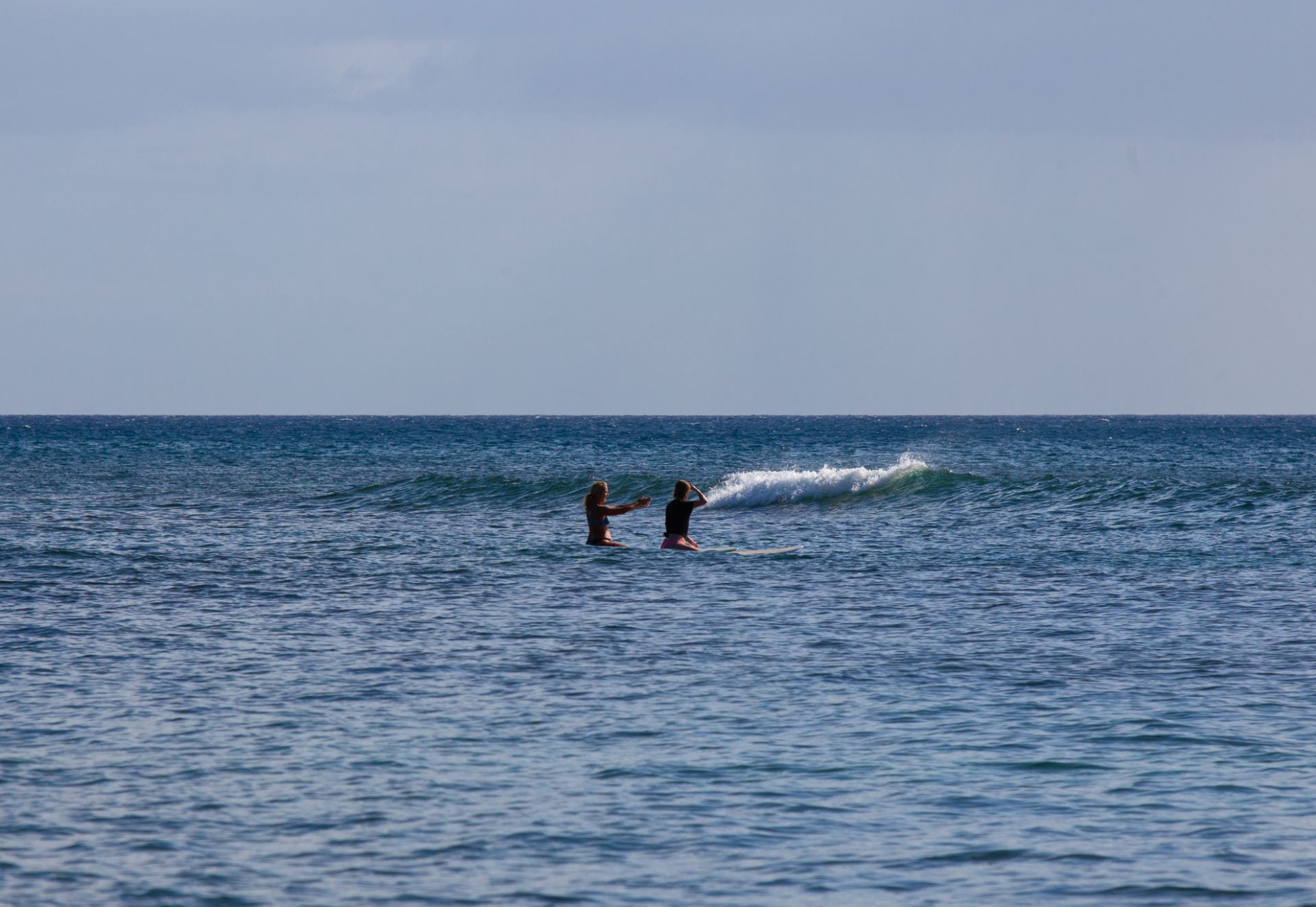
Photo by Elisabeth Hadjis | A pair of surfers chat while waiting for the perfect wave at Maria’s Beach. Surfing is a popular after-work activity for locals here, giving them a chance to get together, unwind and enjoy the outdoors.
Flores believes that the best way to do this is with education, and has noticed that locals in the area are becoming more aware of what they can do to protect the coral reefs around them.
“A lot of these people live and have businesses that surround surf lessons, [tour] guiding, so it’s very important for us to keep those natural resources in check,” he said. “I think locals really engage with that, just because they’re protecting not only their lifestyle, but their livelihood.”
While Flores’ goals for ocean education are important in the fight to keep Puerto Rico’s corals healthy, others have taken a different approach to the restoration of the reef. In the shallow waters off the island of Culebra, nearly 70 miles east of San Juan, a team of researchers and conservationists is working to better understand the challenges facing the local elkhorn community and the ecosystem that these corals support.
Edwin Hernandez-Delgado is one of the scientists responsible for this initiative. Based in San Juan, Hernandez-Delgado is a professor of environmental sciences specializing in coral reef ecology at the University of Puerto Rico in Rio Piedras, as well as the senior scientist Sociedad Ambiente Marino, a non-profit ocean conservation organization. At the Culebra reef, Hernandez-Delgado and his team are working to rehabilitate corals by populating the dead reef with new, healthy specimens one by one.
“We grow them and we multiply them,” he said while standing at the sandy shoreline of Escambron Beach. “We transplant corals of meaningful size, so that they can withstand what is going to be out there.”
And what’s out there is proving to be quite challenging for the reef. On Puerto Rico’s east coast, Hernandez-Delgado says overexploitation from irresponsible tourism and development projects too close to the shore pose an urgent threat to corals — especially the elkhorn species, which is highly sensitive to water quality. During hurricane season, this can have serious implications for the 70% of Puerto Ricans who live along the coast and depend on offshore reefs to protect their communities from dangerously high storm surges.
“The reality is that in some areas, we have lost from 50 to 80 percent of the living coral we used to have like 20, 30 years ago,” said Hernandez-Delgado.
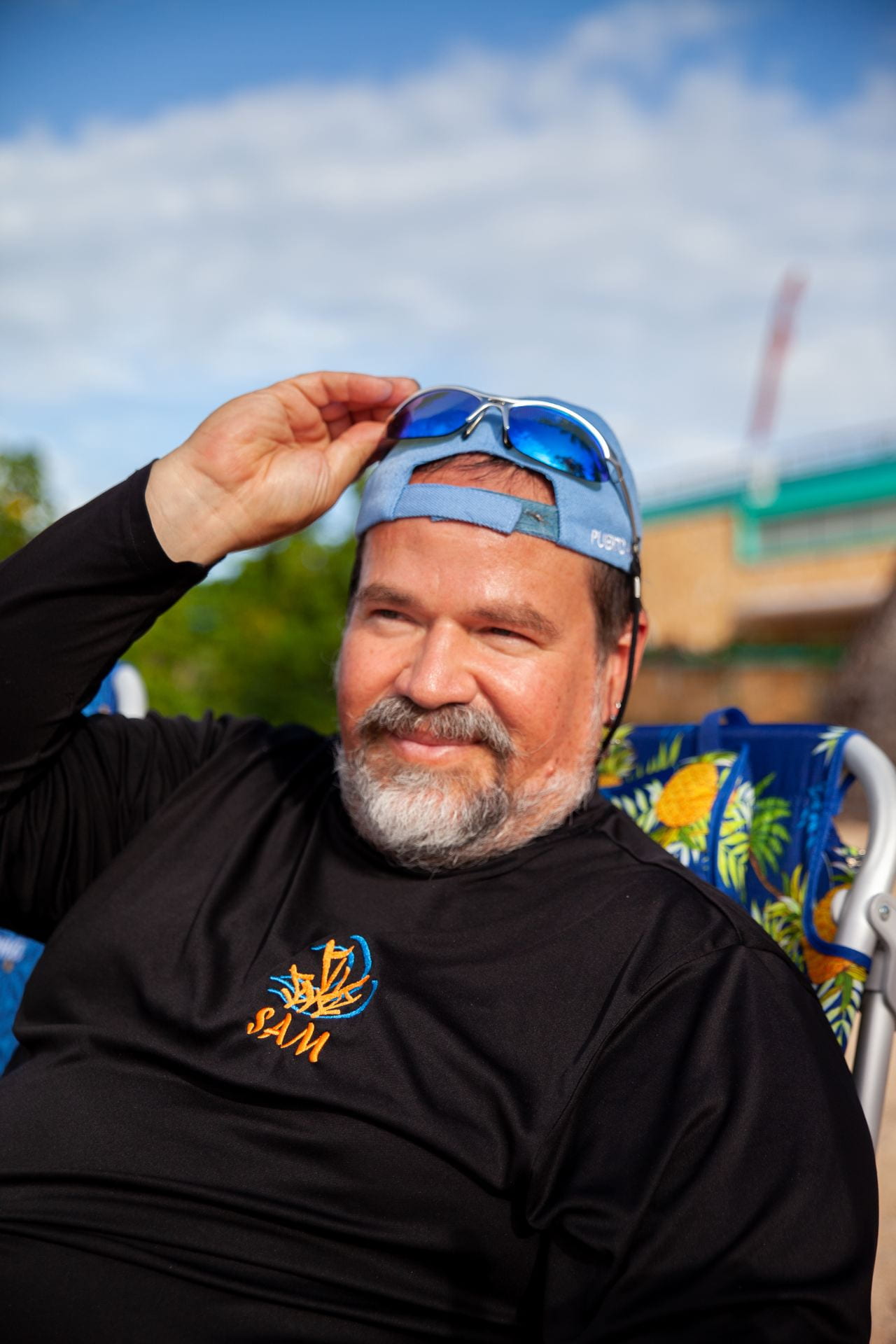
Photo by Maria Bonnemaison | Coral reef specialist and scientist Edwin Hernandez-Delgado sits in a lounge chair at Balneário del Escambrón, looking out at the water and the coral reef below the waves.
Hernandez-Delgado has seen promising results with his research, though, especially when it comes to the resilience of the eastern shore reefs and an artificial coral project, designed to increase biodiversity by attracting more fish to the area, which add nutrients to the region and make the environment more favorable for new coral growth.
Still, those who make a living off the ocean feel that more should be done in the immediate future to improve the health of these ecosystems. Rodriguez, for example, believes that the local dive community would jump at the opportunity to volunteer for coral restoration projects.
“They are growing corals in Culebra, they are growing corals in the Fajardo area,” she said, “but I’m sure there’s a lot more that can be done to restore the coral for Puerto Rico, and I would love to see that.”
As with the Tres Palmas Marine Reserve, ocean lovers like Flores believe that the protection of Puerto Rico’s coral reefs should be a priority for all who enjoy the coastline’s benefits.
“The ocean community is vivid. It’s alive and we’re surrounded by it, right? Every corner of the island has something special to do with the ocean,” said Flores. “If we’re all here to protect the resources, to save ecosystems or to preserve what we already have, that’s kind of the ongoing fight and the common goal.”
